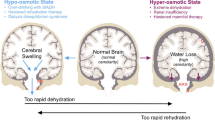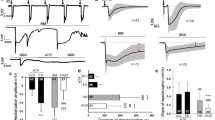Abstract
The extent of anoxic depolarization (AD), the initial electrophysiological event during ischemia, determines the degree of brain region–specific neuronal damage. Neurons in higher brain regions exhibiting nonreversible, strong AD are more susceptible to ischemic injury as compared to cells in lower brain regions that exhibit reversible, weak AD. While the contrasting ADs in different brain regions in response to oxygen–glucose deprivation (OGD) is well established, the mechanism leading to such differences is not clear. Here we use computational modeling to elucidate the mechanism behind the brain region–specific recovery from AD. Our extended Hodgkin–Huxley (HH) framework consisting of neural spiking dynamics, processes of ion accumulation, and ion homeostatic mechanisms unveils that glial–vascular K+ clearance and Na+/K+–exchange pumps are key to the cell’s recovery from AD. Our phase space analysis reveals that the large extracellular space in the upper brain regions leads to impaired Na+/K+–exchange pumps so that they function at lower than normal capacity and are unable to bring the cell out of AD after oxygen and glucose is restored.








Similar content being viewed by others
References
Attwell, D., & Laughlin, S.B. (2001). An energy budget for signaling in the grey matter of the brain. Journal of Cerebral Blood Flow & Metabolism, 21(10), 1133–1145.
Barreto, E., & Cressman, J.R. (2010). Ion concentration dynamics as a mechanism for neural bursting. Journal of Biological Physics, 37(3), 361–373. doi:10.1007/s10867-010-9212-6.
Bazhenov, M., Timofeev, I., Steriade, M., & Sejnowski, T.J. (2004). Potassium model for slow (2–3 Hz) in vivo neocortical paroxysmal oscillations. Journal of Neurophysiology, 92, 1116–1132.
Berthon, B., Burgess, G.M., Capiod, T., Claret, M., & Poggioli, J. (1983). Mechanism of action of noradrenaline on the sodium–potassium pump in isolated rat liver cells. Journal of Physiology, 341, 25–40.
Blanco, G. (2005). Na,k–ATPase subunit heterogeneity as a mechanism for tissue-specific ion regulation. In Seminars in nephrology, vol. 25, pp. 292–303: Elsevier.
Brisson, C.D., & Andrew, R.D. (2012). A neuronal population in hypothalamus that dramatically resists acute ischemic injury compared to neocortex. Journal of Neurophysiology, 108(2), 419–430.
Brisson, C.D., Hsieh, Y.T., Kim, D., Jin, A.Y., & Andrew, R.D. (2014). Brainstem neurons survive the identical ischemic stress that kills higher neurons: insight to the persistent vegetative state. PloS one, 9(5).
Brisson, C.D., Lukewich, M.K., & Andrew, R.D. (2013). A distinct boundary between the higher brains susceptibility to ischemia and the lower brains resistance. PLoS ONE, 8(11), e79,589. doi:10.1371/journal.pone.0079589.
Centonze, D., Marfia, G., Pisani, A., Picconi, B., Giacomini, P., Bernardi, G., & Calabresi, P. (2001). Ionic mechanisms underlying differential vulnerability to ischemia in striatal neurons. Progress in neurobiology, 63 (6), 687–696.
Collins, C.E., Airey, D.C., Young, N.A., Leitch, D.B., & Kaas, J.H. (2010). Neuron densities vary across and within cortical areas in primates. Proceedings of the National Academy of Sciences, 107(36), 15,927–15,932.
Cressman Jr., J.R., Ullah, G., Ziburkus, J., Schiff, S.J., & Barreto, E. (2009). The influence of sodium and potassium dynamics on excitability, seizures, and the stability of persistent states: I. single neuron dynamics. Journal of Computational Neuroscience, 26, 159–170.
Cressman Jr., J.R., Ullah, G., Ziburkus, J., Schiff, S.J., & Barreto, E. (2011). Erratum to: The influence of sodium and potassium dynamics on excitability, seizures, and the stability of persistent states: I. single neuron dynamics. Journal of Computational Neuroscience, 30, 781.
Dahlem, M.A., Schumacher, J., & Hübel, N. (2014). Linking a genetic defect in migraine to spreading depression in a computational model. PeerJ, 2, e379. doi:10.7717/peerj.379.
Dijkhuizen, R.M., Beekwilder, J.P., van der Worp, H.B., van der Sprenkel, J.W.B., Tulleken, K.A., & Nicolay, K. (1999). Correlation between tissue depolarizations and damage in focal ischemic rat brain. Brain research, 840(1), 194–205.
Dobretsov, M., & Stimers, J.R. (2005). Neuronal function and alpha3 isoform of the na/k–ATPase. Frontiers in Bioscience, 10, 2373–2396.
Doedel, E.J., & Oldeman, B.E. (2009). Auto-07p: Continuation and bifurcation software for ordinary differential equations. Montreal: Concordia University.
Falini, A., Barkovich, A., Calabrese, G., Origgi, D., Triulzi, F., & Scotti, G. (1998). Progressive brain failure after diffuse hypoxic ischemic brain injury: a serial MR and proton MR spectroscopic study. American Journal of Neuroradiology, 19(4), 648–652.
Fröhlich, F., & Bazhenov, M. (2006). Coexistence of tonic firing and bursting in cortical neurons. Physical Review E, 74(031922).
Hansen, A.J., & Zeuthen, T. (1981). Extracellular ion concentrations during spreading depression and ischemia in the rat brain cortex. Acta physiologica Scandinavica, 113(4), 437–445.
Herculano-Houzel, S., & Lent, R. (2005). Isotropic fractionator: a simple, rapid method for the quantification of total cell and neuron numbers in the brain. The Journal of neuroscience, 25(10), 2518–2521.
Hines, M.L., Morse, T., Migliore, M., Carnevale, N.T., & Shepherd, G.M. (2004). ModelDB: a database to support computational neuroscience. Journal of computational neuroscience, 17(1), 7–11.
Hodgkin, A.L. (1948). The local electric changes associated with repetitive action in a medullated axon. Journal of Physiology, 107, 165.
Hodgkin, A.L., & Huxley, A.F. (1952a). The components of membrane conductance in the giant axon of Loligo. Journal of Physiology, 116, 473–496.
Hodgkin, A.L., & Huxley, A.F. (1952b). Currents carried by sodium and potassium ions through the membrane of the giant axon of Loligo. Journal of Physiology, 116, 449–472.
Hodgkin, A.L., & Huxley, A.F. (1952c). A quantitative description of membrane current and its application to conduction and excitation in nerve. Journal of Physiology, 117, 500–544.
Hodgkin, A.L., Huxley, A.F., & Katz, B. (1952). Measurement of current–voltage relations in the membrane of the giant axon of Loligo. Journal of Physiology, 116, 424–448.
Hoffmann, U., Sukhotinsky, I., Atalay, Y.B., Eikermann-Haerter, K., & Ayata, C. (2012). Increased glucose availability does not restore prolonged spreading depression durations in hypotensive rats without brain injury. Experimental Neurology, 238(2), 130–132.
Hübel, N., & Dahlem, M.A. (2014). Dynamics from seconds to hours in Hodgkin–Huxley model with time–dependent ion concentrations and buffer reservoirs. PLoS Comparative Biology, 10, e1003,941. doi:10.1371/journal.pcbi.1003941.
Hübel, N., Schöll, E., & Dahlem, M.A. (2014). Bistable dynamics underlying excitability of ion homeostasis in neuron models. PLoS Comparative Biology, 10, e1003,551. doi:10.1371/journal.pcbi.1003551 10.1371/journal.pcbi.1003551.
Ingram, J., Zhang, C., Cressman, J.R., Hazra, A., Wei, Y., Koo, Y.E., žiburkus, J., Kopelman, R., Xu, J., & Schiff, S.J. (2014). Oxygen and seizure dynamics: i. experiments. Journal of neurophysiology, 112 (2), 205–212.
Kager, H., Wadman, W.J., & Somjen, G.G. (2000). Simulated seizures and spreading depression in a neuron model incorporating interstitial space and ion concentrations. Journal of Neurophysiology, 84, 495–512.
Kager, H., Wadman, W.J., & Somjen, G.G. (2002). Conditions for the triggering of spreading depression studied with computer simulations. Journal of Neurophysiology, 88(5), 2700.
Kager, H., Wadman, W.J., & Somjen, G.G. (2007). Seizure–like afterdischarges simulated in a model neuron. Journal of Computational Neuroscience, 22, 105–128.
Krishnan, G.P., & Bazhenov, M. (2011). Ionic dynamics mediate spontaneous termination of seizures and postictal depression state. The Journal of Neuroscience, 31(24), 8870–8882.
Krizaj, D., Rice, M.E., Wardle, R.A., & Nicholson, C. (1996). Water compartmentalization and extracellular tortuosity after osmotic changes in cerebellum of Trachemys scripta. Journal of Physiology, 42(3), 887–896.
Lauderdale, K., Murphy, T., Tung, T., Davila, D., Binder, D.K., & Fiacco, T.A. (2015). Osmotic edema rapidly increases neuronal excitability through activation of NMDA receptor–dependent slow inward currents in juvenile and adult hippocampus. ASN Neuro, 7(5), 1759091415605,115. doi:10.1177/1759091415605115.
Luigetti, M., Goldsberry, G.T., & Cianfoni, A. (2012). Brain mri in global hypoxia–ischemia: a map of selective vulnerability. Acta Neurologica Belgica, 112(1), 105–107.
Mazel, T., Simonov, Z., & Sykov, E. (1998). Diffusion heterogeneity and anisotropy in rat hippocampus. Neuroreport, 9(7), 1299–1304.
McBain, C.J., Traynelis, S.F., & Dingledine, R. (1990). Regional variation of extracellular space in the hippocampus. Science, 249(4969), 674–677.
Mulet, J., & Mirasso, C.R. (1999). Numerical statistics of power dropouts based on the Lang-Kobayashi model. Physical Review E, 59(5), 5400–5405. doi:10.1103/physreve.59.5400.
Murphy, T.H., Li, P., Betts, K., & Liu, R. (2008). Two-photon imaging of stroke onset in vivo reveals that nmda-receptor independent ischemic depolarization is the major cause of rapid reversible damage to dendrites and spines. The Journal of Neuroscience, 28(7), 1756–1772.
Rosenberg, G.A. (1999). Ischemic brain edema. Progress in Cardiovascular Diseases, 42(3), 209–216.
Sawas, A.H., & Gilbert, J.C. (1981). Effects of adrenergic agonists and antagonists and of the catechol nucleus on the Na+, K+–ATPase and Mg2+–ATPase activities of synaptosomes. Biochemical Pharmacology, 30(13), 1799–803.
Schüz, A., & Palm, G. (1989). Density of neurons and synapses in the cerebral cortex of the mouse. Journal of Comparative Neurology, 286(4), 442–455.
Shandilya, S.G., & Timme, M. (2011). Inferring network topology from complex dynamics. New Journal of Physical, 13(1), 013,004.
Somjen, G.G. (2004). Ions in the brain: normal function, seizures, and stroke. USA: Oxford University Press.
Sukhotinsky, I., Yaseen, M.A., Sakadžić, S., Ruvinskaya, S., Sims, J.R., Boas, D.A., Moskowitz, M.A., & Ayata, C. (2010). Perfusion pressure–dependent recovery of cortical spreading depression is independent of tissue oxygenation over a wide physiologic range. Journal of Cerebral Blood Flow and Metabolism, 30(6), 1168–1177. doi:10.1038/jcbfm.2009.285.
Ullah, G., & Schiff, S.J. (2009). Tracking and control of neuronal hodgkin-huxley dynamics. Physical Review E, 79(4), 040,901. doi:10.1103/physreve.79.040901.
Ullah, G., & Schiff, S.J. (2010). Assimilating seizure dynamics. PLoS Comput Biol, 6(5), e1000,776.
Ullah, G., Wei, Y., Dahlem, M.A., Wechselberger, M., & Schiff, S.J. (2015). The role of cell volume in the dynamics of seizure, spreading depression, and anoxic depolarization. PLoS Comparative Biology, 11(8), e1004,414. doi:10.1371/journal.pcbi.1004414.
Wei, Y., Ullah, G., Ingram, J., & Schiff, S.J. (2014a). Oxygen and seizure dynamics: II. computational modeling. Journal of Neurophysiology, 112(2), 213–223.
Wei, Y., Ullah, G., & Schiff, S.J. (2014b). Unification of neuronal spikes, seizures, and spreading depression. Journal of Neuroscience, 34, 11,733–11,743.
Xie, L., Kang, H., Xu, Q., Chen, M.J., Liao, Y., Thiyagarajan, M., O’Donnell, J., Christensen, D.J., Nicholson, C., Iliff, J.J., Takano, K., Deane, R., & Nedergaard, M. (2013). Sleep drives metabolite clearance from the adult brain. Science, 342(6156), 373–377. doi:10.1126/science.1241224.
Yao, W., Huang, H., & Miura, R.M. (2011). A continuum neural model for the instigation and propagation of cortical spreading depression. Bulletin of Mathematical Biology, 73(11), 2773–2790. doi:10.1007/s11538-011-9647-3.
Zamecnik, J., Homola, A., Cicanic, M., Kuncova, K., Marusic, P., Krsek, P., Syková, E., & Vargova, L. (2012). The extracellular matrix and diffusion barriers in focal cortical dysplasias. European Journal of Neuroscience, 36, 2017–2024. doi:10.1111/j.1460-9568.2012.08107.x.
Zandt, B.J., ten Haken, B., van Dijk, J.G., & van Putten, M.J. (2011). Neural dynamics during anoxia and the “wave of death”. PLoS ONE, 6, e22,127. doi:10.1371/journal.pone.0022127.
Acknowledgments
This study was supported by a startup grant from College of Arts and Sciences awarded to Ghanim Ullah.
Author information
Authors and Affiliations
Corresponding author
Ethics declarations
Conflict of interests
The authors declare that they have no conflict of interest.
Additional information
Action Editor: J. Rinzel
Rights and permissions
About this article
Cite this article
Hübel, N., Andrew, R.D. & Ullah, G. Large extracellular space leads to neuronal susceptibility to ischemic injury in a Na+/K + pumps–dependent manner. J Comput Neurosci 40, 177–192 (2016). https://doi.org/10.1007/s10827-016-0591-y
Received:
Revised:
Accepted:
Published:
Issue Date:
DOI: https://doi.org/10.1007/s10827-016-0591-y




